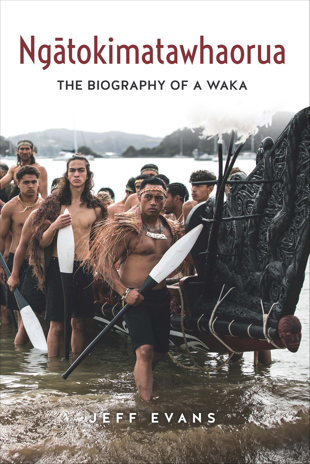Q1: What drew you to write the story of this particular waka?
Ngātokimatawhaorua is an iconic waka taua, and not just for its size. It is intrinsically connected to the commemoration of the signing of the Treaty of Waitangi, so holds a special place in the history of Aotearoa New Zealand. Interacting with the waka in any way — whether it be as a crew person, a support person, a visitor to the Treaty Grounds, or as a spectator when it is out on the water — leaves an indelible memory, and that was certainly the case for me. The sight of a full crew paddling the waka on Waitangi Day should be witnessed by every New Zealander.
Q2: Why was it built?
Ngātokimatawhaorua was built as the Māori contribution towards commemorating the signing of the Treaty of Waitangi. An interesting part of its history is the conflict that arose when Waikato experts were sent north to help oversee its construction. Certain factions in the north were less than impressed.
Q3: Ngātokimatawhaorua is the longest waka built in modern times, and it is an impressive sight. What were the challenges of building waka taua in the twentieth century?
When Princess Te Puea decided to sponsor the construction of several waka taua for the 1940 commemoration of the Treaty of Waitangi, she was faced with what looked for some time as an unassailable challenge. She needed to find a tohunga tārai waka, an expert canoe builder, capable of building the waka taua she wanted. It wasn’t until Rānui Maupakanga introduced himself in 1936 that she found her man. Already well advanced in years, he had built a waka for Te Puea’s grandfather, Tāwhiao. The skill Maupakanga brought with him to the project would in turn be passed on to others, and the ancestral knowledge, so nearly lost without the foresight of Te Puea, can still be seen in the waka built and used today.
Q4: After the 1940 commemorations, for many years Ngātokimatawhaorua sat idle. What was the catalyst for its restoration?
The waka sat unused in a whare waka (canoe shed), alongside Te Whare Wananga, for 34 years until it was decided to relaunch the waka for Queen Elizabeth’s 1974 visit.
Q5: What are some of the highlights of the waka’s story?
One of the special moments was watching R.G.H (Jim) Manley’s movie footage of the building of the waka in the documentary Mana Waka. Manley captured the process of the construction from cutting down of the trees in Puketi Forest, to the bullocks dragging the logs, each weighing many tonnes, out for the forest, to them being shaped into the beautiful waka that we can now appreciate. His footage was critical in describing that part of the waka’s story. Another interesting period was when the waka and its crew were caught in the crossfire during the volatile Treaty protests, especially in the 1980s and 1990s. Eyewitness accounts are of the time are fascinating.
Q6: What does the story of Ngātokimatawhaorua tell us about Aotearoa’s history over the last 50 years?
Ngātokimatawhaorua is just one of many waka from up and down the nation that have helped Māori reconnect with the skills and values of their ancestors. From war canoes through to the great double-hulled voyaging canoes that still sail the Pacific, they all have a place when it comes to enriching the lives of those that spend time on or with them. By reaching back into the past, today’s leaders are able to forge a meaningful future for those that follow.
Q7: Have you had the opportunity to be on the water with Ngātokimatawhaorua?
I haven’t spent time on the waka itself, but I have been out on a support boat shadowing the great waka, and being out there, metres from the action, just reinforced the mana the waka has, as well as the high level of skill the crew can call on. Watching the 35.7-metre waka being guided between yachts sitting at anchor also brought home for me just how manoeuvrable the waka is.
Q8: It is apparent from the book that getting Ngātokimatawhaorua on the water is no easy task. What are some of the challenges?
It takes a huge commitment from the senior crew and support staff to ensure the waka is ready each Waitangi Day for its annual appearance. The logistics of feeding 120+ crew every training weekend, as well as during Waitangi Day week, is challenging enough. Add the constant need to train new kaihoe (paddlers) and the attention required to ensure all the lashings on the waka are secure and that the hull is remains watertight, and the duties quickly add up.
Q9: You have been interested in waka of all kinds, and the people who build and crew them, for many years now. What do you think is behind the rise in interest in waka?
Waka are an incredible showcase for Māori craftsmanship, as well as being a very real link back to the ancestors. Ngātokimatawhaorua was built in much the same way as waka taua were built hundreds of years ago, and the skills required to paddle and guide it are also similar, if not the same, as during that earlier period. Many men have mentioned that when they are on the waka they feel that their ancestors are surrounding and supporting them.
Q10: Was there a particularly highlight during your time researching this book?
For me it was spending time with crew, past and present, and hearing their stories, their memories of time with the waka. A particular highlight was camping with the crew one Waitangi Day weekend and getting to meet past crew members who were dropping in to spend time with them. Their memories added a depth to the story that couldn’t be found elsewhere. I even had the opportunity to interview Eru Heperi, who was a bailer on the maiden voyage in 1940.


